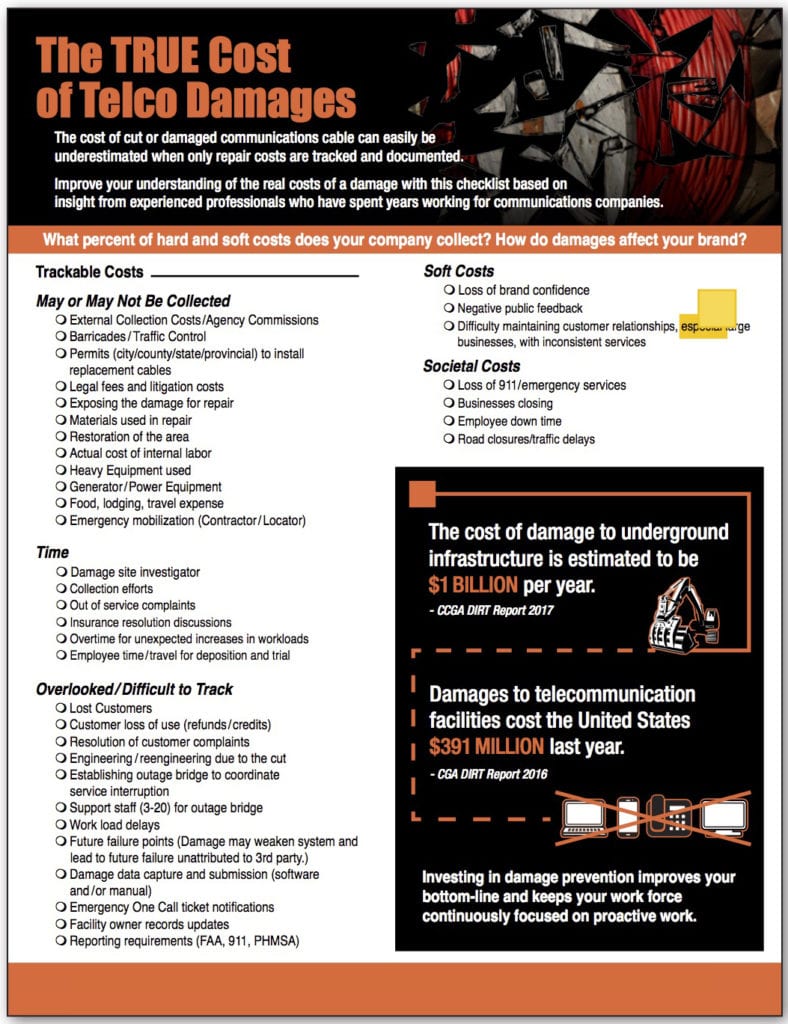by Scott Landes (this article originally appeared in the 2019 spring issue of the dp-PRO magazine)
Communications companies always recover all their costs when their cables are damaged by contractors. If you believe this, I have some bad news… there is no Santa Clause, no Easter Bunny, and communications companies seldom recover anywhere near all the true costs.
When talking to communications stakeholders with firsthand experience with damage investigation, claims recovery, and field operations they all recognize that even if they recover all the actual repair costs, it is still only a fraction of the true costs. When the hard costs are combined with the soft costs, only 40-50% is usually recovered – even when the contractor or locator is 100% at fault. And keep in mind, many times it is neither the locator or the contractor’s fault.
A seasoned telecommunications professional reviewed the checklist below for accuracy and responded to me:
“It does look like a comprehensive approach but to truly do it justice, you would have to put this in book form. It is sad that things in the corporate world have gotten so busy that no one can really get their head around the scope and effect of a damage. To merely provide this list without description should be enough to make anyone sit up and pay attention. Equally so, even those of us that deal with this on a daily basis, although cognizant of the facts, cannot consider all the ramifications when dealing with the damage. This is where the corporate world needs to come into play. Just like the repair technician should be concentrating on restoral, and the investigator concentrating on determination of liability and building a solid case, upper management should be aware of and considering all the mitigating factors listed, and the affect not just on the customer, but also on the company as a whole.”
On top of all these costs which have and will continue to impact the facility owners bottom-line, there are significant societal costs including lost revenue for business, road closures during repairs, people sent home from work due to phone/data services cut off, the severe impact to 911 Call Centers, and the interruption of services from police, fire, ambulance and other emergency responders which could lead to a loss of life when communications are terminated during a time of crisis.
In Canada, the CCGA DIRT report estimated in their last national report on damages that societal costs of damages are $1.5 billion. The 2016 Common Ground Alliance annual DIRT report (CommonGroundAlliance.com) estimates the US societal costs at over $1 billion.
As you read through this checklist on the costs of a cable cut provided by telecommunications professionals, ask yourself:
- What percent of hard costs and soft costs do I actually collect?
- How do damages affect my brand?
Consider this:
Lost Customers: Weather-related loss of service is often acceptable by customers, but loss of service due to non-weather-related issues can lead to the depletion of your customer base and this cost is not tracked as a cost of damage.
Customers loss of use: Usually when a customer asks for credit, they get it. This can be expensive. Many customers have Service Level Agreements (SLAs) which provide rebates to the customer if service levels are not met; some rebates start the first minute of down time. This cost is not included in the cost of damage.
Employee labor costs: While these costs may be included as part of the labor charges, the hourly rate may not be the loaded labor rate. Post-restoration time spent on building damage claims is never included in the cost of damage or collected.
Repair Technician Mobilization: When technicians are pulled away from their regular load to restore damage, overtime is incurred and customer dissatisfaction is created due to deferred repair and installation loads originally scheduled for the day.
Engineering or reengineering costs: There is a reduction in productivity when an engineer is pulled from his work to do emergency design for repairs
Updating records: A hidden cost associated with damage that is usually removed from a challenged bill as an administrative cost.
Locator emergency mobilization: Emergency tickets can be devastating to the locator – rerouting, additional execution time to perform the locate, and the delays to other excavators waiting for locates to perform their work.
Mobilization of dispatch support, monitoring, and verification of repairs: Again, considered administrative, this is another potentially astronomical cost that is often not even considered.
As a whole the telecommunications industry is not engaged in damage prevention. Immersed in damage prevention myself since the early ‘80s, it has always amazed me how many telecommunications companies do not have damage prevention programs or participate in Common Ground Alliance. The most common rationale is that it isn’t necessary as they successfully collect the costs of damages. As you can see here, this is not accurate.
Investing in damage prevention improves your bottom-line and keeps your work force continuously focused on proactive work, improves your image and enhance your customer service. If your priorities are profits, productive employees, and happy customers, making damage prevention a high priority is an easy choice.




